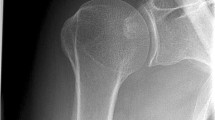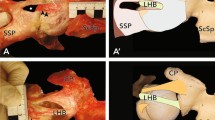Abstract
In order to define the geometry of the coracoacromial arch in both its bony and soft parts and to bring it into relationship with rotator cuff tears, 54 cadaver shoulders (from subjects aged 47–90 years) were dissected And X-rayed (anteroposterior projection and supraspinatus outlet view). Partial rotator cuff tears were assessed additionally by transillumination and polarized microscopy. After transfixation of the coracoacromial arch with a polyurethane mould, sections were made along the coracoacromial ligament. The morphology of the acromion was described following the classification of Bigliani et al. [5]. Amongst other parameters, measurements were taken between the long axis of the scapula, the spina, and the acromion. In 19 of 22 cases, a traction osteophyte was associated with rotator cuff tears. In incomplete tears, spurs were completely encased within the ligament and did not impair the subacromial space. The number of rotator cuff tears was significantly increased in shoulders with “curved” acromia, flat acromial slope, and increased angle between the scapular plane and the spina (intact, mean 58°; tears, mean 47°). The morphology of the subacromial space was secondarily determined by this angle. In contrast to Bigliani et al. we were unable to find a “hooked” acromion. These results indicate that the combination of a flat and curved acromion or a position of the acromioclavicular joint above the cranial pole of the glenoid must be regarded as considerable risks for the development of rotator cuff tears. The concept of anterior acromioplasty is supported by our results.
Similar content being viewed by others
References
Aoki M, Ishii S, Usui M (1986) The slope of the acromion and rotator cuff impingement. Orthop Trans 10:228
Aoki M, Ishii I, Usui M (1990) Clinical application for measuring the slope of the acromion. In: Post M, Hawkins RJ, Morrey BF (eds) Surgery of the shoulder. Mosby, St Louis, pp 200–206
Barthel T, Gohlke F, Loehr JF, Gandorfer A, Eulert J (1992) The reliability of the supraspinatus-outlet view in assessing the acromial morphology. Fifth International Conference on Surgery of the Shoulder, Paris, 1992
Bateman JF (1963) The diagnosis and treatment of tears of the rotator cuff. Surg Clin North Am 43:1523
Bigliani LU, Morrison DS, April DW (1986) The morphology of the acromion and its relationship to rotator cuff tears. Orthop Trans 10:216
Codman EA (1934) The shoulder. Thomas Todd, Boston
Drillings G, Nuber G, Swartz S (1991) Strain measurements of the undersurface of the acromion (paper 387). 58th Annual Meeting of the American Academy of Orthopaedic Surgeons, Anaheim, CA, 1991, p 237
Edelson JG, Taitz C (1992) Anatomy of the coracoacromial arch. Relation to degeneration of the acromion. J Bone Joint Surg [Br] 74:589–594
Gohlke F, Lauterbach T, Croissant T, Lippert MJ, Andresen K (1992) The incidence of degenerative changes in the rotator cuff — a sonographic study. J Bone Joint Surg [Br] 74 [Suppl I]:20
Gohlke F, Essigkrug B, Löhr J, Eulert B (1992) The pattern of the collagen fibers of the shoulder capsule. Fifth International Conference on Surgery of the Shoulder, Paris, 1992
Jobe FW (1989) Impingement problems in atheltes. Instr Course Lect 38:205–209
Kohn D, Wülker N, Renner S (1992) Die subakromiale Durchsicht-Aufnahme — eine experimentelle und klinische Studie. Orthop Praxis 3:155–156
Liotard JP, Cochard P, Walch G (1991) Zwei Röntgenzielaufnahmen für den Subakromialraum vor und nach Akromioplastik. Ergebnisse einer Untersuchungsserie von 40 Patienten. Orthopade 20:310–314
Mallon WJ, Brown HR, Vogler JB, Martinez S (1992) Radiographic and geometric anatomy of the scapula. Clin Orthop 277:142–154
Neer CS (1983) Impingement lesion. Clin Orthop 173:70–77
Neer CS, Poppen NK (1987) Supraspinatus outlet. Orthop Trans 11:234
Ogata S, Uthoff HK (1990) Acromial enthesiopathy and rotator cuff tear. A radiologic and histologic postmortem investigation of the coracoacromial arch. Clin Orthop 254:39–48
Ozaki J, Fujimoto S, Nakagawa Y, Masuhara K, Tamai S (1988) Tears of the rotator cuff of the shoulder associated with pathological changes of the acromion. J Bone Joint Surg [Am] 70:1224–1230
Peterson CJ, Gentz CF (1983) Ruptures of the supraspinatus tendon. Clin Orthop 174:143–148
Zuckerman JD, Kummer JF, Cuomo JF, Simon J, Rosenblum S, Katz N (1992) The influence of coracoacromial arch anatomy on rotator cuff tears. J Shoulder Elbow Surg 1:4–14
Author information
Authors and Affiliations
Rights and permissions
About this article
Cite this article
Gohlke, F., Barthel, T. & Gandorfer, A. The influence of variations of the coracoacromial arch on the development of rotator cuff tears. Arch Orthop Trauma Surg 113, 28–32 (1993). https://doi.org/10.1007/BF00440591
Received:
Issue Date:
DOI: https://doi.org/10.1007/BF00440591




